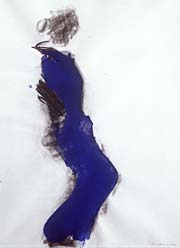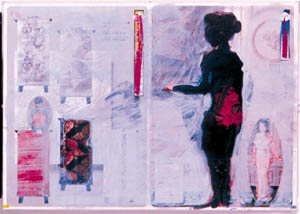Back to basics
Manuel Neri's timeless evocations of the female figure in plaster, bronze, marble and paint on paper have brought him national acclaim. The most powerful of the second wave of Bay Area Figurative artists, he developed in the 1960s an approach to the figure, poised between classicism and abstraction, in which the gestural application of paint in bold strokes both defines and violates the human form. Of his signature figures of the 1960s and '70s, Thomas Albright wrote: "They are at once somnambulant and charged with latent motion, graceless and dignified, vulnerable and self-contained. They suggest the vitality of warm flesh and blood, yet also reveal themselves to be mere armatures covered with a skin of plaster, metal or stone and smeared with paint." Some of that spirit imbues a series of sculptures and paintings on paper, many with a Japanese theme, from the 1980s and '90s at b. sakata garo in midtown. Unlike Neri's vigorous, almost savage, life-sized figures, the sculptures in the show -- marble busts of female heads and bronze maquettes of figures in kimonos -- have a delicate, almost decorative quality. The paintings, some on exquisite Japanese papers and others on printed papers that seem to be magazine pages, for the most part preserve more of the urgency and attack for which Neri is noted, though several seem to be oddly lazy in their handling. Of the sculptures, the four marble busts -- ranging from an unadorned head that draws interest from the natural veining of the marble, to ones smeared with yellow, black and blue paint -- are the strongest pieces. Though their titles suggest Japanese sources, the busts have an exquisite refinement and antique feeling that calls up associations with Egyptian art. The unadorned bust, with its high head covering and delicate, remote features, also reminds one of early 20th century sculpture. The painted works are more emotive, though they, too, are remote -- and the paint further distances them, violating the sense of sculptural volume and masking the features. Painted in vibrant colors of cobalt blue, blue-green and pink, the bronze, kimono-clad, faceless figures are lovely but somehow come off as large figurines. Though they hint at latent motion, they seem static and their lush coloration feels more decorative than transformative. Perhaps at full scale these pieces would take on a more imposing presence and the sense of mystery that is hinted at would become more palpable. A group of paintings on paper from Neri's "Japonais Series" places kimono-clad figures in almost narrative compositions that hint at mysterious relationships. Obliterated faces hover over women in lushly patterned kimonos emerging out of a texturally rich gloom of dark gestural markings. The figures seem to glow out of a lush, muddy soup of browns, blacks and complex grays. Smaller figures from Neri's "Japonesque Series" focus on the graceful postures of women in kimonos rendered with a few simple strokes of the brush. They culminate in "Japonesque Series IX," a large painting on paper of a woman in an electric-blue kimono that is a stunning evocation of the essence of Japanese elegance. Equally imposing is "Makiko I," a large work done in charcoal, dry pigment and water on paper. A deceptively simple yet searing image of a woman in profile with her lovely neck emerging from the fold of her kimono, it's a startling ghostlike image vivified by the smear of blue pigment that defines the woman's hairdo. The show also includes a number of gesture and posture studies in which the figure is reduced to simple forms silhouetted against both murky and bold colors. Neri captures essences of movement and form in these raw images with panache at times, while at other times giving the sense that he is only going through the motions. Nevertheless, they nourish us by example, reminding us that going back to basics is a way of flexing one's artistic muscles so that they will be in shape when works such as "Japonesque Series IX" and "Makiko I" come along.
Manuel Neri
Continues through June 1 at b. sakata garo, 923 20th St.; noon-6 p.m. Tuesdays-Saturdays. (916) 447-4276. |

